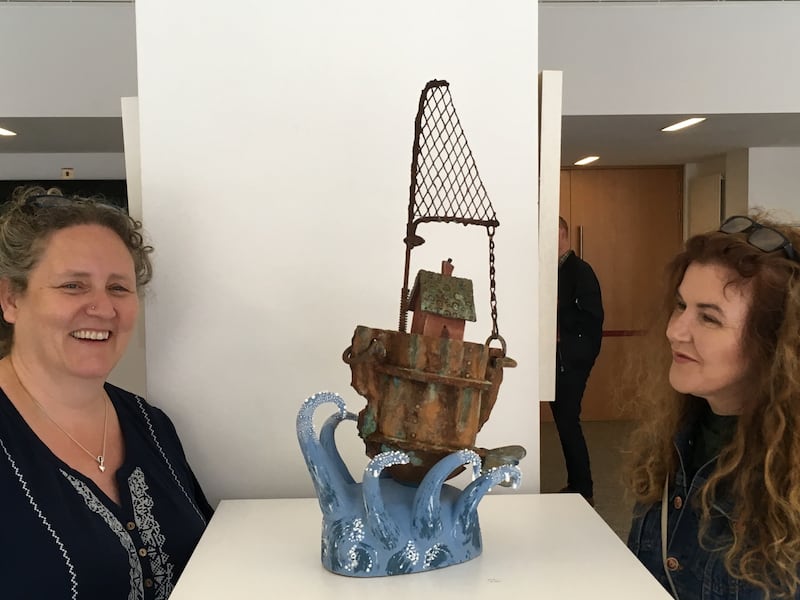Clay/Works, the annual members exhibition of Ceramics Ireland, is open at the Printworks in Dublin Castle and runs until August 31st, showcasing the works of more than 100 members of the guild.
Stone-glazed ceramics now form a whole dedicated area of antiques and collectables.
While the oldest pottery found in Ireland dates from about 6,000 BC – when a Neolithic tomb was discovered in Milltown, Co Kerry, in 2015 – the first uses of Irish pottery were purely utilitarian.

Used at a time when animal skins and bladders were also used as receptacles, old grave sites with shards of pottery can give an insight into the culinary practices of Neolithic farming as a result of protein analysis within the clay.
Today Irish ceramics and pottery are valued for both their functional and aesthetic purposes, a trait that began in the 16th and 17th centuries, when pottery and ceramics became a symbol of wealth.
The kitchen dresser was indicative of the social standing of a family, where imported and finely decorated pottery from abroad were perceived to be exotic.
In 2018, the discovery during excavations close to the Franciscan friary on Sherkin Island, Co Cork, unearthed a wide range of pottery from as far away as China as well as continental Europe.
What surprised archaeologists was the quantity and range of exotic pottery from 16th and 17th century on the site, leading to the realisation that this remote little island was once a thriving international trading hub.
Pottery wars
But possibly throughout the history of ceramics it was the pottery wars between Japan and Korea that had the most impact on these alchemical balls of humble clay.
During the Imijn war of 1592-1598, the Japanese, who prized pottery over all other crafts, kidnapped 6,000 of the finest potters from Korea.
In one of the most brutal wars in Asian history, the potters survived – albeit spending the rest of their lives as artisan slaves – but those less fortunate had their noses removed, as when the Japanese invaded villages, they took human noses as trophies.
The exhibition at Dublin Castle showcases 250 pieces from Ireland’s ceramic artists, from established ceramicists to up-and-coming artists. Included in the event are works by this year’s winners of two industry awards.
First up is Sarah Roseingrave, a graduate of Crawford College in Cork who takes the Blue Egg Gallery Bursary 2019.
Roseingrave also won the Future Makers' Exhibition Support Award in 2018 awarded by Design & Crafts Council of Ireland as part of its makers awards and supports programme, one of the largest of its kind in Europe, for her ceramic and glass works.
The abstract sculptural pieces by Niamh Harte, a graduate of National College of Art and Design in Dublin, whose work has been exhibited at the National Museum of Ireland, took the Scarva/Ceramics Ireland Professional Practice Award 2019.
Beauty of imperfection
Seasoned ceramicist John Quinn who studied ceramic design at the Limerick School of Design in the 1980s admits he "fell in love with clay as it is such a versatile medium, and its possibilities are endless. I particularly like the Japanese concept of wabi-s---abi, which is defined as the beauty of imperfection. While many people see beauty in something new and shiny, I am drawn to old and worn objects which I often incorporate into my work."
Quinn describes the ceramics industry in Ireland as being in a healthy state, despite by being hit by global recession, as “due to the growing number of designers and makers the standards in the industry are rising every year”.
While the highest price achieved in Ireland for a piece of Belleek pottery, which began in 1849, was €9,500, provenance adds value. -For example, a Belleek tea set fetched €23,300 at auction over a decade ago, as it had once belonged to the late American president John F Kennedy.
World stage
Despite this, the recent sale of Bindu, a stoneware and porcelain large-bellied bowl by Grainne Watts through Bonhams this year for €12,889 (including buyer's premium) in its decorative arts and contemporary sale, shows that Irish ceramic artists are now being recognised and celebrated on the world stage.
The playful delicate works by Watts, who takes her inspiration from nature, have earned the artist a string of awards, including 2014 winner of the RDS National Craft and Design Award, and also in the same year an award by Ceramics Ireland.
Alongside the exhibition, the launch of a new book, Ceramics Ireland Celebrating 40 Years of Makers and Community, traces the development of the organisation across the years since 1997, when it was originally called the Craft Potters Society of Ireland and documents the current 158 members’ work with some wonderful illustrations.
Admission to the exhibition at the Printworks in Dublin Castle is free and runs from 10-5pm daily until August 31st. See ceramicsireland.ie













